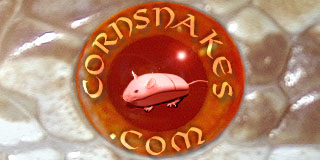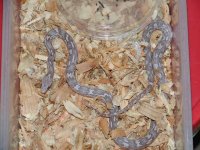Darin Chappell said:
If I'm not mistaken, I believe Don Soderberg told me that he has bred two Aztecs together in the past and gotten some of the resulting offspring to emerge with no aztec pattern whatsoever. If my memory is accurate, then that would eliminate the aztec pattern as being determined by mendelian factors as we currently understand them.
Such a pairing resulting in normal babies precludes a recessive, dominant, or codominant gene from being the causative agent, I believe. Maybe someone could contact Don and ask him first hand, but I'm fairly certain those were his findings.
If the Aztec Pattern gene is co-dominant or maybe semi-dominant then if two Aztecs were bred together that were Het Aztecs then 25% of the offspring would be normal. This is what we see with the Dominant Hypo gene in boas and many other dominant pattern genes in boas. They are an all or nothing dominant gene or semi-dominant in the het form, and dominant specimens are produced when two hets are bred together..
If you breed two Het Hypo Boas together then you will get 75% Hypos and 25% normals. If you breed a Het Hypo Boa to a normal then you will get 50% Hypos and 50% normals. A Homo Hypo boas bred to a Het Hypo will produce 50% Homos and 50% hets but you can’t tell them apart.
The Super Hypos and Super Jungle Boas which are Homo for their gene will produce all Hypos or Jungles when bred to anything. The Jungle Boa is a dominate pattern trait and when in the Super or Homo form, the pattern is very dramatic. A Het Jungle, can look almost like a normal, except for a few markers, or can be half Jungle patterned. This is very similar to what we are seeing in the Aztec Corns.
You can bred two Het Jungles together, which are co-dominant pattern gene, which may be acting like the Aztec pattern, and get normals in the clutch or litter. We have never identified a dominant gene in corns, but there are several in boas. If the Aztec pattern is dominant, this would explain why it pops up so often and you can’t hardly get rid of it. All corns that have a little unusual pattern on them would not necessarily be carrying the Aztec Pattern, but if one has only one little Aztec pattern and it is the Dominant Aztec gene then it would be dominant and pass the pattern onto its offspring.
I am totally speculating at this time, because of my interest in boas, but I do know there are other dominant pattern genes in colubrids as well. The Striped gene in California King Snake is dominant and so is the Aberrant Pattern in them as well. If there are several dominant pattern genes in boas and they also exist in colubrids then it is very possible to exist in corns as well. I have no idea if the zigzag or zipper Corns are the same as the Aztec, but there are several Jungle Boa imitators that are not dominant, but cause by something else. So far I have never bred an Aztec Corn to anything and not got some Aztecs. I have bred Aztec to Aztec and got some normals.



